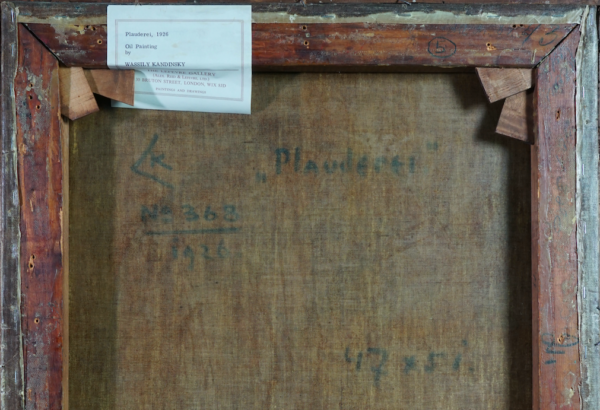Plauderei
Chat
Wassily Kandinsky
1926
Oil on canvas
51 x 47 cm
Acquisition year ante 1983
Inv. 0126
Catalogue N. A119
Provenance
Exhibitions
Bibliography
“The circle is the synthesis of the greatest oppositions. It combines the concentric and the eccentric in a single form, and in balance. Of the three primary forms [triangle, square, circle], it points most clearly to the fourth dimension.”
(Wassily Kandinsky, 1926)
Wassily Kandinsky gave the title Plauderei (Chat) to one of the last works he entered for the year 1926 into his Handlist of paintings (under number 368). He painted it in Dessau, Germany, where the Bauhaus had relocated the previous year. In Dessau, Kandinsky and Klee shared a Masters’ double house with a garden. In the autumn of 1926 Kandinsky continued to teach analytical drawing and theory of form;1 the following spring he and Klee would give easel painting classes in their homes. In January 1926 Punkt und Linie zu Fläche (Point and Line to Plane) was published as the ninth volume in the series of Bauhaus Bücher (Bauhaus Books). It was the artist’s second significant treatise, completed fourteen years after Über das Geistige in der Kunst (On the Spiritual in Art). December 1926 marked Kandinsky’s sixtieth birthday which was celebrated with jubilee exhibitions in Braunschweig, Dresden and other German cities.
Plauderei features circular forms, as do other canvases from 1926: Einige Kreise (Several Circles), Akzent in Rosa (Accent in Pink), In sich (In Itself) and Gelber Kreis (Yellow Circle).2 In addition to the central red circular form, there are circles within it and in two of the rectangular panels at the corners. Bands of parallel lines anchor the four corners and are reminiscent of the diagrams for repetitions of straight lines in Point and Line to Plane. Likewise, Kandinsky discusses circles in his writings and correspondence: “The circle is the synthesis of the greatest oppositions. It combines the concentric and the eccentric in a single form, and in balance. Of the three primary forms [triangle, square, circle], it points most clearly to the fourth dimension.”3
Plauderei was exhibited in 1928 at the Kunsthaus Schaller in Stuttgart. By 1939 it was acquired from the gallerist and artist Rudolf Bauer by the Solomon R. Guggenheim Foundation in New York. Bauer may have obtained the painting at the Galerie Nierendorf in Berlin; he had begun to purchase Kandinsky’s art in 1929, although he and Hilla von Rebay did not meet the artist until 1930.4 The picture was included in the presentation of the Guggenheim Collection in June 1939.5
Kandinsky continued to teach at the Bauhaus after it was forced by the National Socialists to close in Dessau and moved briefly to Berlin. In 1933 Kandinsky decided to leave Germany and go to France, where he lived just outside Paris, in Neuilly-sur-Seine, from 1934 until his death in 1944.
The painting was displayed, together with Herbst bei Murnau and Brauner Ecke, in the so-called “mother’s room” in the villa in Rivoli, where Cerruti kept a copy of the 1959 volume Wassily Kandinsky: Life and Work by Will Grohmann next to the bed.
Vivian Endicott Barnett
1 Weissbach 2015, vol. I, pp. 48-49.
2 Roethel, Benjamin 1984, nos. 767, 769, 774, 779.
3 Grohmann 1959, p. 188.
4 V. E. Barnett, “Rereading the Correspondence: Rebay and Kandinsky”, in New York 2005, pp. 86-100.
5 New York 1939, no. 278 “Round”.
Fig. 1 The back of the painting.

